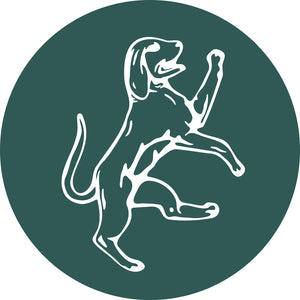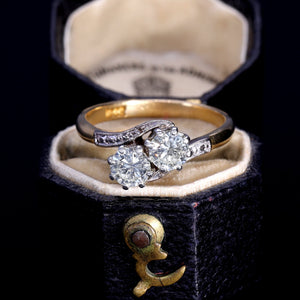Carat Weight in Antique Rings: Understanding Gemstone Carats
When exploring antique rings—pieces often passed down through generations or sourced from bygone eras—one of the most discussed factors is carat weight. While modern jewellery also focuses heavily on the carat measure, antique and vintage rings can present unique considerations. These older gems may feature historical cutting styles like the old mine cut or old European cut, potentially affecting perceived size and brilliance. In this post, we’ll explain carat weight, delve into its historical roots, and provide insights on how it specifically relates to antique rings.
1. What Is Carat Weight?
Carat weight (ct) measures a gemstone’s mass. One carat equals 0.2 grams—about the weight of a small paperclip—and is subdivided into 100 points for precise measurement. For example, a 0.50 ct gem can be called a “50-pointer.” In antique rings, carat weight remains a key metric for determining value, but the impact on visual appearance can vary due to older cutting techniques.
1.1 Historical Origins
- Carob Seeds: Early traders used carob seeds as uniform weights, which gave rise to the term “carat.”
- Standardized Measurement: Modern labs now define one carat as exactly 0.2 grams, ensuring global consistency—even for gems from centuries past.
2. Carat Weight vs. Size in Antique Rings
In many antique rings, diamond or gemstone cuts differ from modern brilliant styles. As a result, two stones of the same carat weight can look noticeably different in size. Early cutters often sacrificed some weight for maximizing sparkle under candlelight, while others retained heavier “bulky” girdles, affecting how large the gem appears from the top view.
- Old Mine/Old European Cuts: Characterized by smaller tables and higher crowns, these cuts can appear deeper and may look smaller from above—despite a comparable carat weight.
- Modern Recutting: Occasionally, antique gems are recut to highlight brilliance, but doing so might reduce the original carat weight.
3. How Do I Calculate Carat Weight?
If you have the precise weight of a gem in grams, finding its carat weight is simple:
- Carat Weight (ct) = [Gem Weight in Grams] ÷ 0.2
For a 0.40-gram gemstone, the stone weighs 0.40 ÷ 0.2 = 2.00 carats. However, many antique rings lack modern documentation, making it challenging to confirm a stone’s exact carat weight unless examined by a qualified gemologist or with updated appraisal tools.
4. Why Carat Weight Matters for Antique Rings
Carat weight is a prominent factor in determining a gemstone’s market value, but it’s far from the only consideration—especially in older pieces.
- Rarity and Provenance: Antique rings can carry historical significance or come from notable eras (e.g., Victorian, Edwardian) that influence desirability beyond carat weight alone.
- Era-Specific Cuts: A 1-carat diamond from the early 1900s may appear smaller yet have a distinct, romantic sparkle, appealing to collectors who value authenticity.
- Condition: Wear, damages, or previous resizing may affect the ring’s structural integrity and overall worth.
5. Additional Factors Influencing Value
Carat weight is just one aspect—other attributes often weigh equally, if not more, in an antique ring’s final appraisal.
5.1 Cut, Clarity, and Colour
- Cut: Even in antique gems, superior angles and facets can enhance brilliance.
- Clarity: Eye-clean stones tend to fetch higher prices, though some inclusions may serve as proof of an older gem’s authenticity.
- Colour: Subtle tints can add charm or detract from desirability, depending on the era and gemstone type.
5.2 Historical Significance
- Design Era: Pieces from well-known design movements (Art Deco, Edwardian) or recognized jewellers can demand premiums.
- Family Heirlooms: Additional provenance—like original receipts or hallmarks—may boost collectible value.
6. Tips for Buying Antique Rings by Carat Weight
If you’re seeking an antique ring and want to balance carat weight with other factors, keep these pointers in mind:
- Consider Certified Appraisals: Modern gemological evaluations can confirm a stone’s weight, clarity, and other traits.
- Examine Cut and Condition: An older diamond might appear smaller, but a well-preserved old European cut can offer unparalleled romance in its sparkle.
- Budget Flexibly: Antique rings with lower carat weights but exceptional craftsmanship or historical appeal can rival higher-carat pieces in overall value.
- Embrace Uniqueness: The charm of an antique ring often lies in its one-of-a-kind nature. A 0.90-ct gem with vintage cut details might be more enchanting than a standard 1.00-ct modern round diamond.
Conclusion
Carat weight—a tradition rooted in carob seeds—serves as a standard measure for evaluating gemstones across time. In antique rings, this metric remains essential, but it’s best viewed alongside factors like historical design, cutting style, condition, and provenance. Understanding how carat weight translates (or doesn’t) to perceived size and sparkle in older gems can help you find a ring that merges historical allure with lasting brilliance—perfect for those who value both heritage and beauty in their jewellery.


